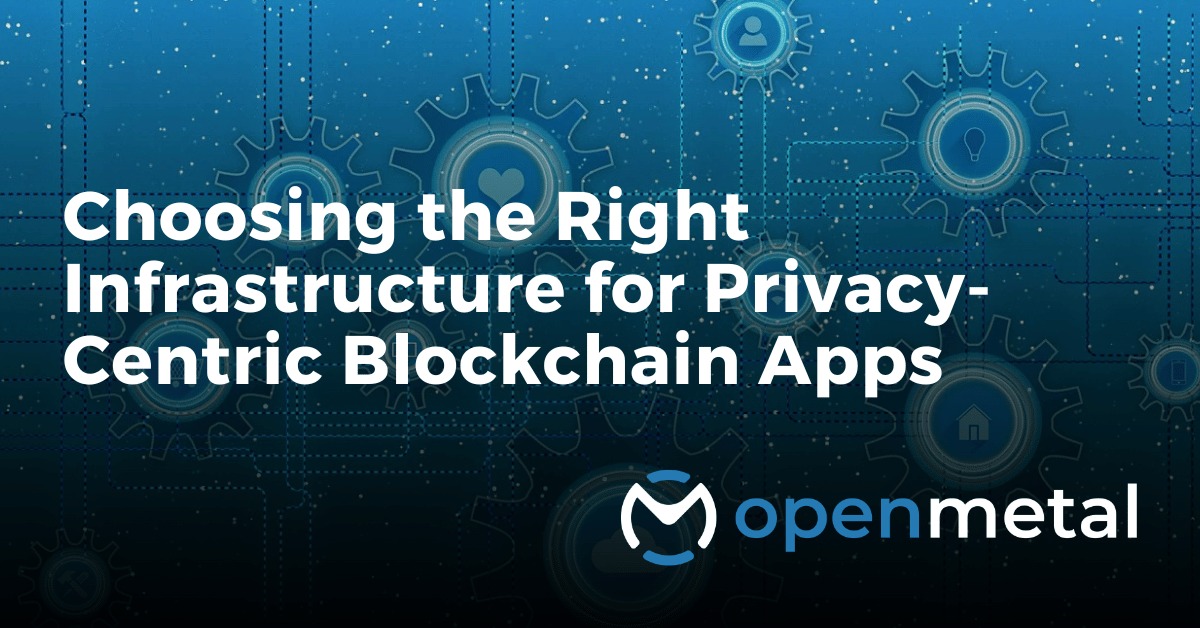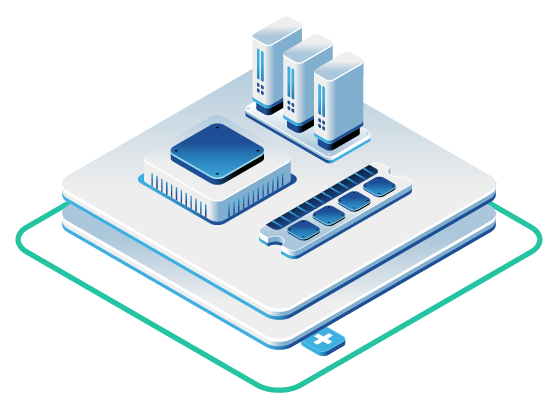
Privacy-first blockchain applications face a unique infrastructure challenge. You’re not just running standard web apps—you’re building systems that handle sensitive data, protect user anonymity, and maintain cryptographic integrity while supporting zero-knowledge proofs, multi-party computation, and confidential smart contracts. If your team is working on privacy-centric blockchain applications, your infrastructure requirements go far beyond what traditional cloud providers can deliver.
You need infrastructure that gives you control over the full stack, predictable performance for consensus mechanisms, and isolation that protects sensitive cryptographic operations. Most importantly, you need an environment where privacy isn’t just an afterthought—it’s built into the foundation.
What Makes Privacy-Centric Blockchain Infrastructure Different?
Privacy-focused blockchain applications operate fundamentally differently from traditional distributed systems. Privacy-preserving blockchains enhance confidentiality and anonymity while maintaining transparency and immutability, using various cryptographic techniques including Zero-Knowledge Proofs (ZK Proofs), private transactions, ring signatures, homomorphic encryption, state channels, sidechains, and private smart contracts.
Unlike public blockchains where transparency is the default, privacy-centric applications must balance selective disclosure with regulatory compliance. Here’s what that means for your infrastructure:
Confidential Computing Requirements: Your applications need hardware-based trusted execution environments (TEEs) to protect data while it’s being processed. Confidential computing protects data in use by allowing workloads to run inside isolated, hardware-encrypted environments that even the host system can’t see. Technologies like Intel TDX create secure enclaves where your zero-knowledge circuits or multi-party computation protocols can run without exposing sensitive data to the underlying infrastructure.
Network Isolation and Metadata Protection: The Nym mixnet addresses the network layer by encrypting internet traffic into identically sized packets, mixed with ‘dummy’ packets, sent through three layers or ‘hops’ into mix ‘nodes’ distributed around the world at randomized times and intervals. Your infrastructure must support similar network-level privacy protections through VLAN isolation, encrypted channels, and traffic analysis resistance.
Performance Consistency for Cryptographic Workloads: Zero-knowledge proof generation, homomorphic encryption operations, and secure multi-party computation protocols require predictable compute resources. Performance variability in shared cloud environments can break consensus mechanisms or create timing vulnerabilities in your cryptographic protocols.
Why Standard Cloud Infrastructure Falls Short
When it comes to supporting privacy-centric blockchain apps, there’s a real infrastructure gap in most cloud options—especially for teams that care about full control, predictable latency, and data isolation. Traditional cloud providers struggle with several fundamental limitations:
Shared Tenancy Risks: In multi-tenant environments, your sensitive workloads share physical hardware with unknown applications. Even with virtualization, side-channel attacks, memory leakage, and resource contention can compromise the privacy guarantees your applications depend on.
Limited Hardware Control: Without verifiable control over each layer—hardware, firmware, hypervisor, and OS—you’re introducing gaps where data could be exposed or policies bypassed. Most public cloud providers don’t give you access to CPU pinning, NUMA alignment, or the ability to configure trusted execution environments according to your specific privacy requirements.
Network Transparency: Standard cloud networking exposes metadata about your application traffic patterns. For privacy-centric blockchain applications, this can reveal sensitive information about transaction flows, validator communications, or user interaction patterns that undermine your privacy guarantees.
Compliance and Jurisdictional Concerns: Privacy-preserving blockchains offer improved data protection for personal information such as healthcare records, allowing individuals and organizations to transact and share data without exposing unnecessary details to the public through the use of view keys that grant view-only access. Cloud providers often can’t provide the jurisdictional control and compliance guarantees needed for applications handling sensitive personal data.
How Bare Metal and Private Cloud Support Privacy-First Applications
When you’re building confidential smart contracts or deploying MPC nodes that rely on consistent data flow, dedicated infrastructure provides the foundation you need. Here’s how bare metal servers and hosted private clouds address the specific requirements of privacy-centric blockchain applications:
Hardware-Level Isolation: Dedicated bare metal servers eliminate the shared tenancy risks that can compromise privacy guarantees. You get exclusive access to CPU, memory, and I/O resources, ensuring that your cryptographic operations can’t be observed or interfered with by other tenants.
Confidential Computing Support: Modern bare metal infrastructure supports Intel TDX and AMD SEV technologies out of the box. TEEs act like a vault around your application, isolating it from everything else—even the operating system and hypervisor, ensuring that only verified workloads can run and that sensitive data remains sealed off from potential attacks.
Network Control and Segmentation: Private cloud deployments give you full control over network topology, allowing you to implement the sophisticated isolation and traffic protection patterns that privacy-centric applications require. You can configure dedicated VLANs for different application components, implement traffic mixing to resist analysis, and control egress patterns.
Predictable Performance: Dedicated resources ensure that your zero-knowledge proof generation, consensus mechanisms, and cryptographic operations have consistent access to CPU, memory, and network bandwidth. This predictability is crucial for applications where timing attacks or performance degradation can compromise security.
OpenMetal’s Infrastructure Advantage for Privacy-Centric Applications
OpenMetal offers infrastructure purpose-built to become a cloud that addresses the specific challenges of privacy-centric blockchain applications. Most providers give you dedicated servers, but they stop there. OpenMetal actually delivers fully-automated OpenStack-based clouds on top of that hardware, available on-demand or reserved.
Privacy-First Networking: The networking is a major reason teams choose OpenMetal—especially ones working on modular or ZK-based chains where timing and consistency matter. The default setup includes DDoS protection and full layer 2 VLAN isolation between environments, with no charges for egress. The performance is consistent because the entire stack is isolated, and the private networks used for storage replication and internal communication are fast and predictable.
Enterprise-Grade Security: OpenMetal operates out of serious locations—real data centers like Iron Mountain and Cyxtera, not just random leased space. This signals to customers in finance, healthcare, and Web3 that operations are at a level where compliance and physical security are taken seriously. Hardening your stack with confidential computing becomes practical when you have control over the full infrastructure stack.
Direct Engineering Support: The support side makes a difference when running infrastructure that underpins financial protocols or privacy-first applications. OpenMetal works directly with infrastructure teams—not just through ticketing systems—and that’s valuable when people are running infrastructure that requires deep technical expertise.
Key Infrastructure Components for Privacy-Centric Blockchain Apps
When evaluating infrastructure for privacy-focused blockchain applications, you need to consider several critical components:
Compute and Confidential Processing: Look for Intel 5th Generation Xeon processors with TDX support or AMD processors with SEV capabilities. These provide the hardware-level trusted execution environments needed for confidential smart contracts and secure multi-party computation. Your infrastructure should support memory encryption, attestation, and secure boot processes.
High-Performance Storage: Privacy-centric applications often work with large cryptographic datasets—zero-knowledge proofs, encrypted state data, and confidential transaction histories. NVMe storage with hardware encryption provides the performance and security needed for these workloads. Consider distributed storage systems like Ceph for high-availability scenarios where data replication across multiple nodes is required.
Network Isolation and Performance: Your network architecture should support multiple isolation levels—from basic VLAN segmentation to more sophisticated traffic mixing and metadata protection. Look for providers that offer dedicated bandwidth, predictable latency, and the ability to configure custom routing patterns.
GPU Acceleration for ZK Workloads: Many privacy-centric blockchain applications benefit from GPU acceleration for zero-knowledge proof generation. For those who require GPU acceleration during training, OpenMetal offers H100 GPUs that can be attached to TDX-enabled virtual machines using PCIe passthrough. This combination provides both privacy protection and computational performance.
Use Cases: Where Privacy Infrastructure Makes the Difference
Privacy-centric blockchain applications span multiple industries and use cases, each with specific infrastructure requirements:
Confidential DeFi Protocols: Building decentralized exchanges or lending platforms that protect user transaction data while maintaining regulatory compliance. These applications need confidential computing environments for order matching, risk calculation, and compliance reporting while keeping individual user data private.
Healthcare and Genomic Privacy: Privacy preserving blockchains offer improved data protection for personal information such as healthcare records, allowing individuals and organizations to transact and share data without exposing unnecessary details to the public. Infrastructure must support HIPAA compliance, data residency requirements, and the ability to run secure multi-party computation on sensitive medical data.
Enterprise Privacy Solutions: Companies need to share confidential business data—supply chain information, financial data, or proprietary research—without exposing it to competitors or the public. This requires infrastructure that can support confidential smart contracts and selective disclosure mechanisms.
Identity and Authentication Systems: Privacy-preserving identity solutions need infrastructure that can support zero-knowledge proofs for authentication while protecting user privacy. These systems often require integration with existing enterprise identity providers while maintaining strong privacy guarantees.
Check out OpenMetal’s analysis of blockchain workloads that absolutely should not be on shared public cloud for more examples of applications that require dedicated infrastructure.
Privacy Infrastructure Comparison
Feature | Public Cloud | Hosted Private Cloud | Bare Metal |
Tenant Isolation | Virtualized | Full | Full |
| Hardware Control | None | Partial | Complete |
| Confidential Computing | Limited | Available | Native |
| Network Customization | Basic | Full | Full |
| Performance Consistency | Variable | High | Highest |
| Compliance Control | Limited | High | Complete |
| Cryptographic Acceleration | Shared | Dedicated | Dedicated |
The choice between hosted private cloud and bare metal often comes down to operational complexity versus maximum control. Private cloud gives you the flexibility to scale resources dynamically while maintaining isolation, while bare metal provides the ultimate in performance and security for the most sensitive workloads.
Deployment Strategies for Privacy-Centric Applications
When deploying privacy-first blockchain infrastructure, consider these architectural patterns:
Hybrid Confidential Computing: Deploy your most sensitive components—like key management, zero-knowledge proof generation, or confidential smart contract execution—in TEE-enabled environments while using standard infrastructure for less sensitive operations like public data indexing or user interfaces.
Network Segmentation Strategy: Implement multiple network isolation layers. Use dedicated VLANs for different application components, encrypted tunnels for cross-region communication, and traffic mixing to prevent network analysis. Consider implementing patterns similar to Nym’s mixnet approach for maximum metadata protection.
Compliance-First Architecture: Design your infrastructure deployment to meet regulatory requirements from day one. This includes data residency controls, audit logging, key escrow capabilities, and the ability to provide selective disclosure for regulatory compliance while maintaining user privacy.
Performance Optimization: For applications using zero-knowledge proofs or other cryptographically intensive operations, optimize your deployment for the specific computational patterns your application requires. This might include GPU acceleration for proof generation, high-memory configurations for large circuit compilation, or specialized networking for multi-party computation protocols.
For detailed implementation guidance, review OpenMetal’s guide on confidential computing for multi-party computation.
The Future of Privacy Infrastructure
The privacy-centric blockchain space is evolving rapidly, with new cryptographic techniques and regulatory requirements driving infrastructure innovation. Achieving strong privacy often involves trade-offs with scalability, as the complex cryptographic operations required for privacy can impact the speed and efficiency of the blockchain network. However, advances in hardware acceleration, specialized processors for cryptographic workloads, and more efficient zero-knowledge proof systems are making privacy-first applications more practical.
Organizations building privacy-centric blockchain applications should plan for infrastructure that can adapt to these evolving requirements. This means choosing providers that invest in the latest confidential computing technologies, support emerging cryptographic acceleration hardware, and can provide the compliance frameworks needed for regulated industries.
Getting Started with Privacy-First Infrastructure
If you’re building privacy-centric blockchain applications, the infrastructure decisions you make early will impact your ability to deliver on your privacy guarantees. Here’s how to get started:
- Assess Your Privacy Requirements: Identify which components of your application need confidential computing, what level of network isolation is required, and what compliance frameworks you need to support.
- Evaluate Infrastructure Options: Compare the capabilities of different infrastructure providers in terms of confidential computing support, network isolation, compliance certifications, and support for cryptographic acceleration.
- Plan Your Architecture: Design your deployment to separate public and private components, implement appropriate network isolation, and plan for the computational requirements of your cryptographic workloads.
- Implement Incrementally: Start with your most privacy-sensitive components and gradually expand your deployment as you validate performance and security characteristics.
OpenMetal’s infrastructure provides the foundation for privacy-centric blockchain applications that need to balance strong privacy guarantees with regulatory compliance and business requirements. Whether you’re building confidential DeFi protocols, privacy-preserving identity systems, or enterprise blockchain solutions, the right infrastructure makes privacy practical.
Ready to deploy privacy-first blockchain infrastructure? Contact OpenMetal to discuss your specific requirements, or explore hosted private cloud options that provide the isolation and control your privacy-centric applications need.
Read More on the OpenMetal Blog


































